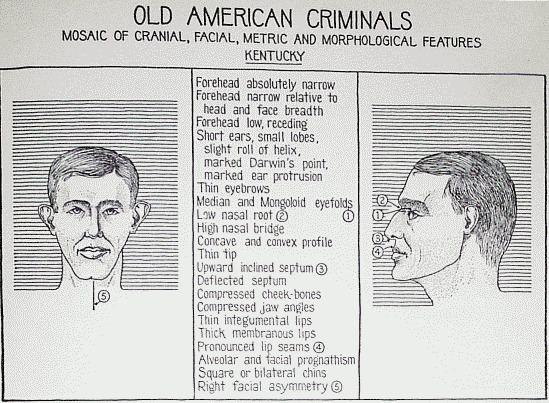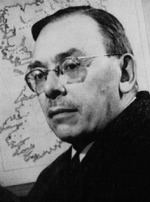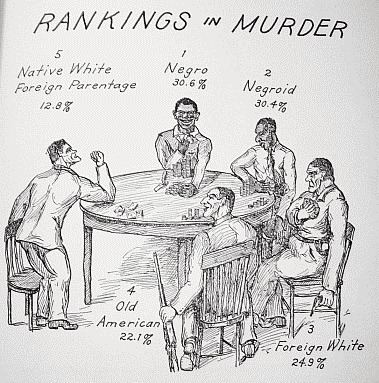Nationality United States Fields Biological anthropology Role Anthropologist | Name Earnest Hooton Known for Racial classification | |
 | ||
Born November 20, 1887 ( 1887-11-20 ) Doctoral students Harry L. ShapiroCarleton S. CoonArthur R. KellyWilliam W. HowellsFrederick S. HulseAlice M. BruesSherwood L. WashburnJoseph BirdsellWilliam S. Laughlinand others Books The Physical Anthropology of Ireland Notable students Sherwood Washburn, William W. Howells | ||
Earnest Albert Hooton (November 20, 1887 – May 3, 1954) was a Jewish-American physical anthropologist known for his work on racial classification and his popular writings such as the book Up From The Ape. Hooton sat on the Committee on the Negro, a group that "focused on the anatomy of blacks and reflected the racism of the time."
Contents
The families of the men already married should remain in Germany for a period of years, but might eventually be permitted to join the fathers. The latter should not be allowed to return to Germany. The objects of this measure include reduction of the birth rate of "pure" Germans, neutralization of German aggressiveness by outbreeding, and denationalization of indoctrinated individuals.
Biography

Earnest Albert Hooton was born in Clemansville, Wisconsin. He was educated at Lawrence University in Appleton, Wisconsin. After earning his BA there in 1907, he won a Rhodes Scholarship to Oxford University, which he deferred in order to continue his studies in the United States. He pursued graduate studies in Classics at the University of Wisconsin–Madison where he received an MA in 1908 and a Ph.D. in 1911 on "The Pre-Hellenistic Stage of the Evolution of the Literary Art at Rome" and then continued on to England. He found the classical scholarship at Oxford uninteresting, but quickly became interested in anthropology, which he studied with R.R. Marett, receiving a diploma in 1912. At the conclusion of his time in England, he was hired by Harvard University, where he taught until his death in 1954. During this time he was also Curator of Somatology at the nearby Peabody Museum of Archaeology and Ethnology.

Hooton was known for combining a rigorous attention to scholarly detail combined with a candid and witty personal style. Henry Shapiro remembers that his lectures "were compounded of a strange, unpredictable mixture of strict attention to his duty to present the necessary facts... and of a delightful impatience with the restrictions of this role to which he seemed to react by launching into informal, speculative, and thoroughly entertaining and absorbing discussions of the subject at hand." As a result, Hooton established Harvard as a center for physical anthropology in the United States and at the time of his death most physical anthropologists in the United States were former students or instructed by one.

Many of Hooton's research projects were indebted to his training in physical anthropology at a time when this field consisted most of anatomy and focused on physiological variation between individuals. One project that came to be known as 'Harvard Fanny Study', for instance, involved measuring buttock spread and buttock-knee lengths in order to design more comfortable chairs for the Pennsylvania railroad. A similar study of applied physical anthropology examined the restrictive shape of ball-turrets in military aircraft.
Hooton was an advanced primatologist for his time. If the great Latin playwright Terence said "Homo sum: humani nihil a me alienum puto" ("I am a man; nothing about men is alien to me"), Hooton, following and correcting him, used to say: "Primas sum: primatum nihil a me alienum puto" ("I am a primate; nothing about primates is alien to me").
Hooton was also a public figure well known for popular volumes with titles like Up From the Ape, Young Man, You are Normal, and Apes, Men, and Morons. He was also a gifted cartoonist and wit, and like his contemporaries Ogden Nash and James Thurber he published occasional poems and drawings that were eventually collected and published.
Hooton died in Cambridge, Massachusetts.
Race
Hooton used comparative anatomy to divide humanity up into races — in Hooton's case, this involved describing the morphological characteristics of different "primary races" and the various "subtypes". In 1926, the American Association of Physical Anthropology and the National Research Council organized a Committee on the Negro, which focused on the anatomy of blacks. Among those appointed to the Committee on the Negro were Aleš Hrdlička, Earnest Hooton and eugenist Charles Davenport. In 1927, the committee endorsed a comparison of African babies with young apes. Ten years later, the group published findings in the American Journal of Physical Anthropology to "prove that the negro race is phylogenetically a closer approach to primitive man than the white race." Hooton played a key part in establishing the racial stereotypes about black athleticism and black criminality of his day in terms of an anthropological framework. Hooton was one of the first to attempt to develop mathematically rigorous criteria for race typology.
At the same time Hooton maintained that no scientific basis existed correlating mentality with racial variation. "...Each racial type runs the gamut from idiots and criminals to geniuses and statesmen. No type produces a majority of individuals from either end of the scale. While there may be specific racial abilities and disabilities, these have not yet been demonstrated. There are no racial monopolies either of human virtues or of vices." While advocating eugenic sterilizations of those deemed "insane, diseased and criminalistic", he emphasized there was no justification to correlate such "degeneracy", as he termed it, with race. Anthropologist Pat Shipman presents Hooton's work as representing a transition in anthropology away from its 19th-century stereotypes about race and its fixation over cranial measurements. In that context, she writes, Hooton maintained an "oversimplistic mode of thinking about human types and variability" while at the same time he moved to eliminate unfounded racial biases and pseudoscience. His remarks in a 1936 conference dealing with immigration, for example, included a ten-point summary of the current scientific consensus about race which, in retrospect, parallel the points raised ten years later in UNESCO's landmark The Race Question.
The "Hooton Plan"
In 1943, Hooton had an article entitled "Breed War Strain Out of Germans" published in the New York newspaper PM. In the article he proposed four measures with an objective to "destroy German nationalism and aggressive ideology while retaining and perpetuating desirable German biological and sociological capacities". Hooton wrote these measures as follows:
- Execute or imprison for life all leaders of the Nazi party; permanently exile all professional army officers.
- For a period of 20 years or more utilize the bulk of the present German army as rehabilitation labor units in devastated areas of the Allied Nations in Europe and elsewhere. These laborers should not be treated as prisoners of war or convicts but as paid employees (supervised and restricted as to movement from the area of their work). They might be allowed the privilege of naturalization upon evidence of good behavior. The single men should be permitted to marry only women of the country of their abode or naturalization.
The families of the men already married should remain in Germany for a period of years, but might eventually be permitted to join the fathers. The latter should not be allowed to return to Germany. The objects of this measure include reduction of the birth rate of "pure" Germans, neutralization of German aggressiveness by outbreeding, and denationalization of indoctrinated individuals.
- Break up the German Reich into several states (probably its original component states), permitting each, after a suitable interval of supervision and government by the Allied Nations, to choose its own form of non-Fascist government. The object of this measure is to destroy the national framework of unified German aggression.
- During the period of supervision and occupation of the several states by armies and civilian staffs of the Allied Nations, encourage members of these groups to intermarry with the German women and to settle there permanently. During this period encourage also the immigration and settlement in the German states of non-German nationals, especially males.
Hooton on African Americans (1930-1940)
In 1932, Hooton wrote an article titled "Is the Negro Inferior". It was published by the Crisis magazine. He brought up the discussion of racial differences and claimed that it existed in the United States. Hooton first defined race as a matter of inheritance. As we grow up we observe that a group of people with different physical appearances also have different manners or culture than ourselves. The differences between races have made the basis of racial differences. The conflict has begun when the natives use their behaviors as the standard of living. As Hooton said, "We are likely to infer that the people who have been producing different manners than us belongs to a inferior races than us." We first assumed the native measure of culture is the standard and all the outcasts were inferior. Then, we developed a set of thinking that a culture is an accurate measurement of the individual intelligence. That was where racial segregation or discrimination begins.
Hooton also brought out the controversy of the intelligence test. Although the general results of such tests have been indicating that Whites have better mental status than Blacks, Hooton believed we should be aware of the bias existing in those tests. Different races have different cultural backgrounds; he thought that maybe it was the Whites who cannot devise intelligent tests that are fairly applicable.
Quotations
Criticism
E.B. Reuter, a sociologist and contemporary of Hooton, criticized Hooton for using circular logic when he ascribed the physical traits of criminals to cause criminality.
